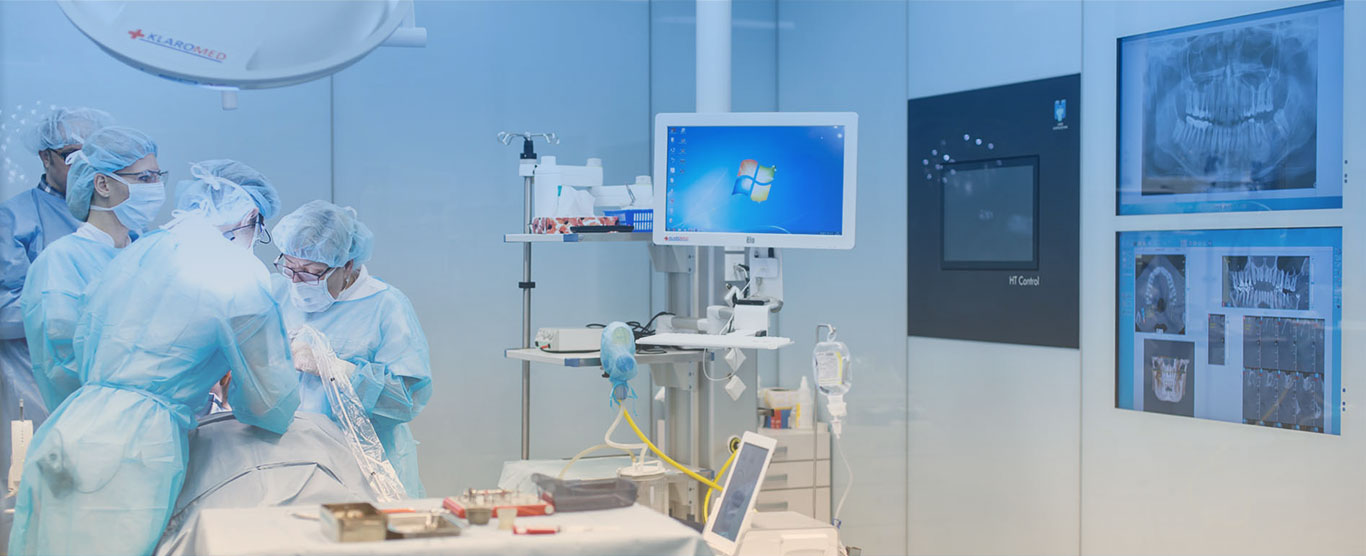Diagnostic
One of the most important stages of the dental treatment is planning.
Obtaining the result expected by the patient usually requires:
- talking to the patient
- individual assessment in the dental chair
- thorough diagnostics
In HAHS clinic the treatment is always preceded by thorough diagnostics. Precise diagnostics are achieved through the use of appropriate equipment. We use, among others:
- digital X-ray images
- digital tomography
- diagnostic laser DIAGNOdent
- electronic 3D facebow (ARCUS DIGMA)
The starting point in treatment planning in each patient is the so called panoramic x-ray.
This X-ray image is a flat (2D) picture, which allows an initial assessment of the general condition of the teeth and bones. In the clinic we use the innovative, digital Hyperion X9 scanner. It provides high definition images, much more precise than the conventionally developed and digitalized X-ray films. It exposes patient to lower radiogenic doses as well.
We perform the examination of cavity advancement using the diagnostic laser DIAGNOdent.
It replaces imperfect, traditional tools (probe and a mirror). When exposed to the laser light, the cavity affected area starts to fluoresce. The measurement result is displayed on the screen. This examination often allows diagnosis without a need to refer to X-ray imaging.
Appropriate diagnostics have a special significance in the case of prosthetic and implantology treatment.
Whether the patients are satisfied with their new teeth depends on how precisely the dentist reconstructs the dental conditions of the patient as well as the appropriate esthetics of the crowns made. Working on the reconstruction of a patient's teeth neither the dentist nor the prosthetic technician can allow themselves to work based just on a rough estimate. Regardless whether they are reconstructing just one lost tooth, or several. It is important that collection of appropriate information on the patient's oral cavity is done at the beginning of the prosthetic work. Only when equipped with suitable information can they proceed to the treatment, preparing the crowns or dentures. Each patient bites differently, with different strength and different placement of the teeth. In HAHS clinic we make the dentures and crowns based on the computer diagnostics of lower jaw movements in relation to the upper jaw. For that, we use an [b]electronic 3D facebow (ARCUS SIGMA)[/b], which allows us to transfer the three dimensional image of both jaws of the patent to the computer. After processing the collected data with special software we can perfectly reconstruct the bite conditions of the patient and transfer them to an articulator, in which we make and set the teeth of the patient. It guarantees elimination of bite overload and prevents teeth from forcing each other out. As a consequence it prevents the loss of implants and unbeneficial changes in facial joints.
Implantology treatment
When planning implantology treatment, it is extremely vital to precisely determine the condition of the patients’ bones in the place, where the implants are to be fixed. The bone profile (its width and height) mainly determines:
- Number of necessary implants
- Type, model, length and diameter of the implants
- Necessity of bone reconstruction in the planned implantation place
Flat panoramic images often do not allow completely precise diagnosis of the bone condition. Carrying out implantology treatment without an in-depth analysis of the bone condition would mean that significant decisions regarding the course of the procedure would be made during its course, increasing the risk of its failure. Comprehensive analysis of the bone conditions is performed using images taken with the New Tom 5G scanner. It is state-of-the-art [digital tomography, which allows us to reconstruct bone structures of the patient's scull in three dimensions. By analysing this image with the specially designed software, we plan an optimum implants’ placement and further treatment stages. Moreover, the procedure can be “performed” virtually (on a computer), and only then on a patient.
The consequences of imprecise diagnostics
The consequences of imprecise diagnostics and superficial analysis of the dental conditions in an individual patient are extremely serious. The most serious are, among others, overloading and forcing each other out by incorrectly placed new teeth, loss of implants as well as changes in the facial joints (often painful).

